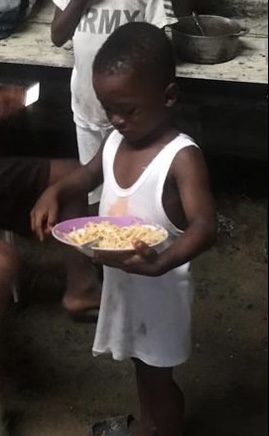Today, in our second exploration of a “A Day in the Life”, we share the way food insecurity and scarcity impacts the Keyara’s Gift community. Again, we’d like to express our thanks to the students and parents, who shared so vulnerably with the Keyara’s Gift staff who conducted interviews.
By metaphorically “stepping into their shoes,” we hope to share a glimpse of their reality and to underscore the urgency and importance of your concern and support.
Day 2: Hunger Pangs: A Liberian Reality
It’s shocking for most North Americans to learn that the majority of Liberians eat only one meal a day, usually in the afternoon between 12-3 p.m. A minority might also have rice for breakfast.
Food insecurity is less of a surprise when one considers the nation's bleak economic plight. The 2021 Global Hunger Index classifies Liberia’s level of hunger as serious - ranking Liberia near the bottom at 110 out of 116 countries on hunger conditions.
The World Bank’s 2021 Poverty and Equity brief estimates that of 5.4 million Liberians:
50.9% live below the national poverty line
More than 44% live under $1.90 a day, the extreme international poverty line
~2.3 million people are unable to meet their basic food and non-food needs
67% of an average household’s spending is for food (74% for the poorest 40%)

Despite a conducive climate and good soils for crop production, as a nation, Liberia has low local agricultural productivity. They are highly dependent on imported staples - making them vulnerable to global food, fuel, and transportation price volatility.
Rice is Life
“If you haven’t eaten rice, you haven’t eaten.” A key staple food, 80% of Liberia’s rice is imported, making it subject to global price “shocks” like war, inflation, fuel costs, food commodity pricing, and climate or harvest crises.
Other Ingredients
Rice is typically accompanied by a vegetable stew and a sauce. Tribal and cultural affiliations often dictate how spicy a sauce might be, from very plain to HOT - think habanero and scotch bonnet chillies kind of heat! When the budget allows, fish or meat will be included.
In addition to rice, other popular ingredients include cassava, bananas, citrus fruit, pineapple, mangos, sweet or regular plantains, coconut, okra, cow peas (black-eyed peas), palm oil, butterball (a small vegetable similar to eggplant), and sweet potatoes (including its green leaves.)
The Kitchen
In both urban and rural kitchens, cooking is primarily done with charcoal or firewood. Without refrigeration, most fish and meat is smoked and few benefit from, nor have familiarity with, modern domestic appliances. Source
Meet Rachel.

6th Grader, Rachel, is 12 years old and lives with her mom and siblings in Montserrado County. She has been a sponsored student for five years.
Rachel’s morning begins at 6 a.m. when she wakes to the sound of motorcycles and the smell of smoke. By 6:45 a.m. she has already washed the dishes, gathered water, and cleaned the house and yard - ready to walk to school, which starts at 7:45 a.m., with her school friends. During the rainy season it’s hard to get everything done before she must leave the house.
Rachel helps her mom smoke small dried fish, known as “boney”, which are a major source of protein in Liberia. “Bushmeat” or wildlife species hunted for human consumption also contributes to the Liberian diet.
It’s not the rain or heat, the street noise, or chores that she finds most challenging about her day - it’s leaving home without breakfast and staying at school, all afternoon, without lunch. Instead, Rachel studies in the afternoon and looks forward to dinner, which will be her only meal of the day.
One meal Rachel really enjoys is a popular West African dish - rice with Pepper Soup. If her mom is able, she’ll add smoked fish or another protein to a stew of onions, chili peppers, tomatoes, “bitter ball” (small bitter eggplant), mixed garlic and seasonings.
In the evening Rachel’s chores include reading her lesson and doing homework, collecting water, helping her mom wash dishes and smoke fish, and bathing herself - all before she goes to sleep at 7p.m. As she closes her eyes she smells the scent of smoking fish. Maybe tomorrow will include Pepper Soup.
Meet Samuel.

34-year-old Samuel lives with his wife and four children in an impoverished community outside Monrovia, on Old Smyth Road. They struggle with food scarcity, flooding, a lack of electricity, health care, and other basic needs. Winner and Esther, above, are sponsored by Keyara’s Gift.
It’s 6:30 a.m. when Samuel starts his day. Because it's the rainy season, the air is cold and he smells the pungency of his wet sleeping mat. The sound of frogs and chickens are occasionally drowned out by the buzz of passing motorbikes.
Like most of his peers, Samuel wakes every morning with the same thought. “How will I feed my family today?”
Six days a week, Samuel drives a borrowed motorbike, shuttling people through the streets of Monrovia, eking out enough money for food. It is hard, irregular, and noisy work - but his only option. His wife, Promise, contributes what she can by offering housekeeping services in the neighborhood. Each day is a challenge and dinner is not a guarantee but on a good night they’ll gather together and enjoy rice with stewed vegetables and dried fish.

Thank you for exploring “A Day in the Life” with us.
And to those who’ve already helped us reach 79% of our goal to sponsor 122 students this year - THANK YOU!!
Inflation has hit hard this year and the cost has risen to $550 per student - leaving us with $14,300 to reach our goal.
Can you help us get 26 more students to school?
No amount is too small!
With gratitude for your continued interest and support,
Karen & Kreig Ecklund
Founders, Keyara's Gift
Want to donate by check? Here are the instructions.
































